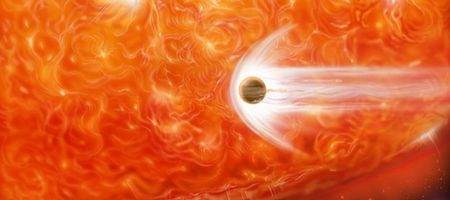NASA scientists have caught a star in the act of swallowing up a planet, the first time such a thing has ever been observed.

The planet was devoured as the star, BD+48 740, began expanding into a red giant – as our own will someday.
“A similar fate may await the inner planets in our solar system, when the sun becomes a red giant and expands all the way out to Earth’s orbit some five-billion years from now,” says Alex Wolszczan of Penn State University.
The team also discovered a massive planet in a surprisingly elliptical orbit around the same star.
They were using the Hobby-Eberly Telescope to study the aging star, which has a radius about eleven times that of the sun, and to search for planets around it.
A detailed spectroscopic analysis showed that the star contains an abnormally high amount of lithium, a rare element created primarily during the Big Bang 14 billion years ago. It’s easily destroyed in stars, which is why its abnormally high abundance in this older star is so unusual.
“Theorists have identified only a few, very specific circumstances, other than the Big Bang, under which lithium can be created in stars,” says Wolszczan. “In the case of BD+48 740, it is probable that the lithium production was triggered by a mass the size of a planet that spiraled into the star and heated it up while the star was digesting it.”
Further evidence comes from the highly elliptical orbit of the star’s newly discovered planet, which is at least 1.6 times as massive as Jupiter.
“We discovered that this planet revolves around the star in an orbit that is only slightly wider than that of Mars at its narrowest point, but is much more extended at its farthest point,” says Andrzej Niedzielski of Nicolaus Copernicus University in Torun, Poland.
“Such orbits are uncommon in planetary systems around evolved stars and, in fact, the BD+48 740 planet’s orbit is the most elliptical one detected so far.”
The astronomers suspect that the dive of the missing planet toward the star before it became a giant could have given the surviving massive planet a burst of energy, throwing it into an eccentric orbit like a boomerang.
“Catching a planet in the act of being devoured by a star is an almost improbable feat to accomplish because of the comparative swiftness of the process, but the occurrence of such a collision can be deduced from the way it affects the stellar chemistry,” says Eva Villaver of the Universidad Autonoma de Madrid.
“The highly elongated orbit of the massive planet we discovered around this lithium-polluted red-giant star is exactly the kind of evidence that would point to the star’s recent destruction of its now-missing planet.”






